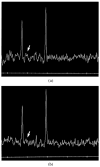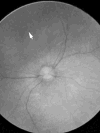X-linked creatine transporter defect: a report on two unrelated boys with a severe clinical phenotype
- PMID: 16601897
- PMCID: PMC2393549
- DOI: 10.1007/s10545-006-0123-4
X-linked creatine transporter defect: a report on two unrelated boys with a severe clinical phenotype
Erratum in
- J Inherit Metab Dis. 2006 Dec;29(6):764. Anselm, IM [corrected to Anselm, IA]
Abstract
We report two unrelated boys with the X-linked creatine transporter defect (CRTR) and clinical features more severe than those previously described with this disorder. These two boys presented at ages 12 and 30 months with severe mental retardation, absent speech development, hypotonia, myopathy and extra-pyramidal movement disorder. One boy has seizures and some dysmorphic features; he also has evidence of an oxidative phosphorylation defect. They both had classical absence of creatine peak on brain magnetic resonance spectroscopy (MRS). In one, however, this critical finding was overlooked in the initial interpretation and was discovered upon subsequent review of the MRS. Molecular studies showed large genomic deletions of a large part of the 3' end of the complete open reading frame of the SLC6A8 gene. This report emphasizes the importance of MRS in evaluating neurological symptoms, broadens the phenotypic spectrum of CRTR and adds knowledge about the pathogenesis of creatine depletion in the brain and retina.
Figures


References
-
- Bizzi A, Bugiani M, Salomons GS, et al. X-linked creatine deficiency syndrome: a novel mutation in creatine transporter gene SLC6A8. Ann Neurol. 2002;52:227–231. - PubMed
-
- Brustovetsky N, Brustovetsky T, Dubinsky JM. On the mechanisms of neuroprotection by creatine and phosphocreatine. J Neurochem. 2001;76:425–434. - PubMed
-
- Cooper LL, Hansen RM, Darras BT, et al. Rod photoreceptor function in children with mitochondrial disorders. Arch Ophthalmol. 2002;120:1055–1062. - PubMed
-
- Das AM, Ullrich K, Isbrandt D. Upregulation of respiratory chain enzymes in guanidinoacetate methyltransferase deficiency. J Inherit Metab Dis. 2000;23:375–377. - PubMed
Publication types
MeSH terms
Substances
Grants and funding
LinkOut - more resources
Full Text Sources

